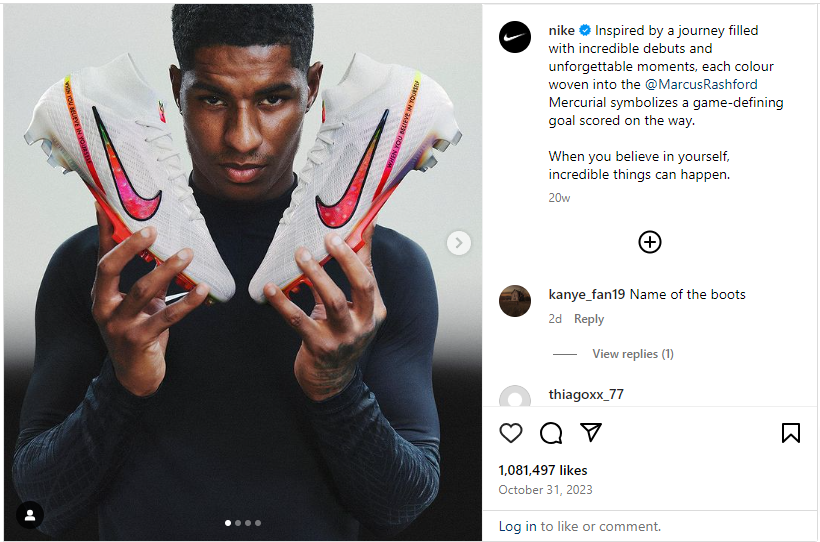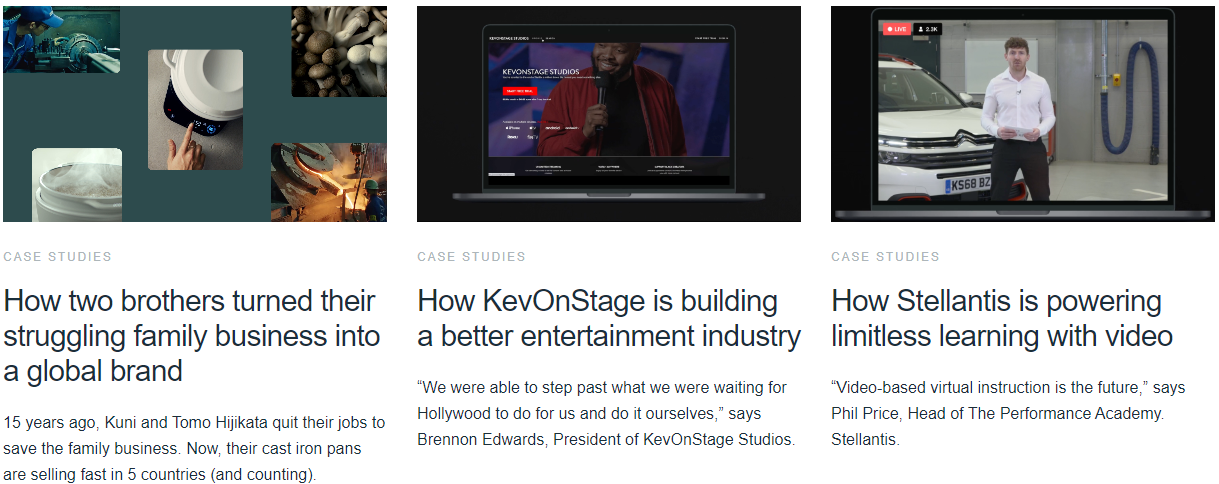Video content has surged to the forefront as a pivotal player in the promotion and selling of products. With an estimated 84% of consumers saying they’ve been convinced to buy a product or service by watching a brand’s video, the power of video marketing can no longer be considered just an accessory to traditional marketing methods. Boost Sales with Visual Engagement Boost Sales with Visual Engagement: Video content has surged to the forefront as a pivotal player in the promotion and selling of products. With an estimated 84% of consumers saying they’ve been convinced to buy a product or service by watching a brand’s video, the power of video marketing can no longer be considered just an accessory to traditional marketing methods.

It’s clear that videos possess the unique ability to capture and maintain user attention, making them an indispensable tool for businesses looking to grow their reach and drive sales. Product videos, in particular, offer a visual and immersive experience that can effectively communicate a product’s value and uses, significantly enhancing sales and brand visibility.
This article will uncover the key elements that make a product video compelling and provide eight actionable tips for businesses looking to harness the power of video marketing.
Table of Contents
ToggleWhat are Product Videos?
Product videos are a form of digital content specifically designed to showcase a product’s features, advantages, and usage to potential customers. They are a critical tool in the marketing and sales process, often leading to informative and persuasive visual experiences that can influence purchasing decisions.
Types of Product Videos
- Demonstration Videos: Visual guides demonstrating how a product works, allowing viewers to see it in action.
- Testimonial Videos: First-hand accounts from satisfied customers endorsing the product.
- Animated Explainer Videos: Animated sequences that explain the product’s purpose and benefits engagingly.
Product videos attract and retain customer attention, often delivering complex information more effectively than text could. They are utilized across various platforms, including e-commerce sites, social media, and email marketing campaigns, to create a more dynamic and immersive experience for shoppers.
By employing various formats of product videos, brands can cater to the diverse preferences of their target audience, offering multiple entry points for engagement. Whether it’s through a detailed demonstration, emotional video testimonials, or creative animated explainers, product videos help simplify the buyer’s journey from awareness to purchase.
Elements of a Compelling Product Video- Boost Sales with Visual Engagement
When creating a product video, certain elements can significantly increase its effectiveness in capturing interest and converting viewers into customers. Here are some crucial elements of a compelling product video:
1. High-Quality Visuals- Boost Sales with Visual Engagement
High-quality visuals are essential for making a product video stand out. They should showcase the product’s features and benefits with clarity and appeal. Videos with stunning visuals tend to keep viewers engaged and can help convey a product’s premium qualities.
2. Engaging Storytelling
Storytelling connects viewers emotionally to the product by relating to their needs and desires. A well-crafted narrative illustrates how the product fits into the consumer’s lifestyle or solves their problems, making the video memorable and persuasive.
For example, when showcasing the benefits of using the best-managed WordPress hosting, a narrative could illustrate how seamless hosting solutions empower businesses to focus on their core operations without worrying about website downtimes or technical glitches.
3. Target Audience Focus- Boost Sales with Visual Engagement
Videos must resonate with a specific target audience. By understanding the audience’s preferences, pain points, and behavior, one can tailor content that appeals directly to them, making the product video more relevant and impactful.
4. Clear Call-to-Action
A clear call-to-action (CTA) tells viewers exactly what to do next, such as ‘Buy Now,’ ‘Learn More,’ or ‘Sign Up.’ It must be concise and prominently placed to guide viewers toward the desired action after watching the video.
5. Brand Consistency
Maintaining brand consistency ensures that the video aligns with the company’s identity, values, and messaging. This reinforcement helps build trust and recognition, making future marketing efforts more effective.
8 Actionable Tips to Sell Your Products Using Videos
1. Know Your Audience
In the realm of video marketing, understanding one’s audience cannot be overstated. Researching and understanding the target market forms the backbone of any successful video marketing strategy. Marketers should engage with meticulous audience analysis to tailor their messaging effectively. Here’s what you need to consider:
- Demographics: Gather data on age, gender, location, and income. This information can guide the tone, style, and content of the video.
- Interests: What does the audience care about? Aligning video content with their interests encourages engagement.
- Problems and Needs: What challenges does the audience face? Videos should provide solutions or compelling reasons for how the product meets their needs.
- Viewing Habits: Identify when and where the target audience watches videos. This shapes not only the video content but also the distribution strategy.
You should always employ tools like surveys, social media analytics, and customer feedback to gather these insights and establish a closed-loop feedback system. A comprehensive understanding of the audience can result in a more persuasive and relevant marketing video that is more likely to convert potential customers into buyers.
2. Highlight the Benefits, Not Just Features
97% of brands and marketers report that video content has been instrumental in showcasing their product or service offerings to their target customers. However, when creating videos to sell products, it is crucial to concentrate on how the item enhances the customer’s life rather than solely on its features.
Features describe what a product is or has; benefits convey the improvements it offers to the user’s life. Here’s how to focus on benefits effectively:
- Emphasize Convenience: Show how the product simplifies tasks. For example, instead of stating a coffee maker has a timer, demonstrate how it gifts them a few more minutes of sleep by having their morning brew ready when they wake up.
- Enhance Emotional Appeal: Connect the product to positive emotions. If it’s a pair of shoes, don’t just talk about the material; show the joy and confidence one feels wearing them.
- Save Time and Money: Illustrate economic benefits. A feature might be energy efficiency, but the benefit is the money saved on energy bills.
- Personalize the Experience: Use testimonials or scenarios showing the product solving specific problems in real life.
By shifting the focus from features to benefits, viewers can visualize the positive impact the product will have on their daily lives. They are more likely to form an emotional connection and see the value in making a purchase. Remember, people don’t just buy products; they buy better versions of themselves.
Here is a way to structure a video segment that highlights benefits:
- Introduce the Problem: Start with the issue the customer faces.
- Present the Feature: Briefly describe a feature of your product.
- Highlight the Benefit: Immediately explain how that feature translates into a real-life benefit.
Videos should ultimately answer one critical question for the customer: “How will this product improve my life?” By focusing on this in your video content, you tap into the viewer’s desires and priorities.
3. Create a Story Around Your Product
When marketing a product, storytelling can be a powerful tool. A compelling tale fascinates viewers and can make the product more relatable. Use narrative techniques that put your product at the center of a story, integrating it seamlessly into life’s narratives. Consumers often remember products not for what they are but for the stories they represent and the emotional connection they can make.
For example, consider a brand like Nike. They excel at crafting narratives that do more than just showcase athletic wear. They create stories of perseverance, triumph, and personal growth.

The product becomes a character in a larger life story, one that resonates with Nike’s target audience. This approach transforms a simple item of clothing into a symbol of athletic aspiration and achievement.
Here’s how to replicate this approach:
- Identify the Core Message: Start by pinpointing what you want your audience to feel and remember about your product. Is it the sense of adventure, safety, innovation, or community?
- Character Development: Introduce characters that your audience can relate to. They don’t have to be real people but realistic personas that potential customers can see themselves in.
- Plot: Craft a scenario where your product naturally fits into the storyline. The plot should demonstrate the need for your product and how it improves or enhances the situation.
- Setting: The backdrop for your story should be familiar and appealing to the audience, emphasizing how the product fits into their world.
- Resolution: Conclude with a satisfying end that resolves the narrative and leaves a strong impression of your product’s value.
A story well told can make a brand memorable and its products desirable. Using videos that tell these stories can captivate audiences and lead to a strong emotional connection with a brand.
3. Include Customer Testimonials- Boost Sales with Visual Engagement
Customer testimonials are a powerful tool in video marketing, allowing businesses to showcase real-life stories and experiences from satisfied customers. These testimonials work as social proof, reinforcing the credibility and trustworthiness of a product or service.
- Leverage Authenticity: Authentic customer testimonials convey trustworthiness. Ensure the testimonials are genuine; viewers can spot inauthenticity, which could be detrimental.
- Highlight Benefits: Have customers emphasize how your product improved their lives or solved a problem. It’s more impactful for a customer to illustrate the benefits than a straightforward product description.
A notable brand that effectively uses customer testimonial videos is Vimeo. They offer a practical roadmap for creating testimonial videos that resonate with viewers.

By displaying genuine customer experiences showcasing their platform’s benefits, potential clients can visualize its impact on their own projects.
Implementation Steps:
- Identify satisfied customers who represent your target audience.
- Request brief, impactful testimonials focusing on specific benefits.
- Record high-quality video to ensure clarity and professionalism.
- Edit testimonials to highlight critical moments.
When consumers see others voicing their positive experiences with your product, it helps build a level of trust that’s hard to achieve with traditional advertising alone. Companies should always strive to produce customer testimonial videos that feel relatable, offer tangible evidence of satisfaction, and help potential customers make an informed decision.
Using customer testimonials strategically within your video content can enhance the perceived value of your offerings, encouraging others to follow suit and choose your brand over competitors.
Also Read: How To Add Web Stories For WordPress Community Website
5. Optimize for Search Engines and Social Platforms- Boost Sales with Visual Engagement
To sell products using videos effectively, one must ensure they are discoverable on both search engines and social media platforms. Businesses should carefully use relevant keywords in their video titles, descriptions, and tags. These keywords should be chosen based on search trends and align with the product’s features or benefits.
Tags and platform-specific features are also vital for visibility. Tags should be concise and reflect the core content of the video. Including hashtags is crucial for social media platforms as they funnel content into topical streams. Use tools for analytics to monitor and adapt to what resonates with the audience.
When it comes to social platforms, each has certain unique features that can enhance discoverability. For instance:
- On YouTube, leverage the ‘Chapters’ feature to organize content clearly and allow viewers to navigate easily.

- Instagram offers ‘Story stickers’ and ‘Shopping features’ that can drive engagement directly from the video content.
For SEO purposes, the video description is an excellent place to insert keywords. Additionally, youtubers can
- Add subtitles and closed captions, which not only make videos accessible to a wider audience but also indexable by search engines.
- Embed videos on the company website to increase dwell time, an important SEO ranking factor.
Consistent branding across videos helps with recognition and trust. Incorporating the company logo, using a uniform color scheme, and maintaining the same voice tone are practices that can assist with this.
By implementing these SEO and social media optimization strategies, businesses can greatly increase the visibility of their video content and, in turn, improve their product sales.
6. Use High-Quality Production Techniques- Boost Sales with Visual Engagement
To sell products effectively using videos, a focus on high-quality production techniques is crucial. These techniques involve several components that come together to create a polished and professional final product.
- Professional Editing: The editing process is vital to the overall quality of a product video. It ensures a seamless flow of content, which helps in maintaining audience engagement. With the help of free video editing software, you can trim unnecessary footage, arrange clips for optimal storytelling, and add effects that enhance visual appeal. Proper editing can transform a simple sequence into a compelling narrative about the product.
- Sound Quality: Crisp and clear audio is critical. Whether it is voiceover, dialogue, or background music, the sound must be free of echoes and background noise. Good sound quality makes the video more enjoyable and keeps the viewer focused on the product’s message.
- Lighting: Proper lighting can differentiate between an amateur and a professional-looking video. It affects how the product looks and feels to the viewer. Soft, even lighting is often preferred as it reduces harsh shadows and highlights the product’s features.
Best Practices:
- Use a tripod or stabilizing equipment to prevent shaky footage.
- Record audio with a high-quality microphone and consider the acoustics of the recording space.
- Use three-point lighting to create depth and reduce unwanted shadows.
- Color grade your footage to give your video a consistent look and feel.
- For unparalleled visual quality and impact, consider hiring professional photographers & videographers to capture high-definition imagery that complements your video content.
Employing high-quality production techniques enhances the viewer’s experience and increases the likelihood of the product resonating with its intended audience. Remember, in a highly competitive market, attention to these details can set a product apart.
7. Incorporate a Clear and Compelling Call-to-Action
The call-to-action (CTA) is not just an element; it is the turning point between viewer engagement and viewer action. To leverage its potential, one must ensure the CTA is clear and compelling to leverage its potential. Guiding viewers on the next steps involves thoughtfully crafted language and strategic placement within the video content.
First, determine the key objective of the video. Is the goal to generate leads, drive traffic to a website, or perhaps encourage product purchases? Once the aim is defined, craft the CTA to support this goal directly. Use actionable language that creates a sense of urgency or benefit. Phrases like “Sign up today to receive a discount” or “Start your free trial now” tell viewers exactly what action to take and why it’s in their interest.
Placement of the CTA is critical. It should appear at a point in the video when the viewer is most engaged and most likely to take action—typically towards the end after the key message has been delivered, or sprinkled throughout if the video is longer.
Visual cues augment the effectiveness of the CTA. A brightly colored button or an animated graphic can draw the viewer’s eye and encourage clicks.
To validate the effectiveness of your call-to-action, use analytics to track the viewer’s journey post-engagement. This data will not only measure success but also inform future video marketing strategies.
By incorporating a clear and compelling call-to-action, marketers can significantly boost their video’s potential to convert viewers into customers.
Also Read: How To Add Web Stories For WordPress Community Website
8. Measure and Analyze Video Performance- Boost Sales with Visual Engagement
To optimize video content for sales, one must measure and analyze video performance meticulously. Utilizing analytics enables sellers to refine strategy and content, ensuring their videos engage and convert viewers effectively.
Firstly, access your video platform’s analytics dashboard. Platforms like YouTube provide extensive data through YouTube Analytics, where one can track key performance indicators (KPIs).
Key metrics to consider include:
- View count: Measures the reach of your video.
- Engagement: Analyzes likes, shares, and comments.
- Watch time: Indicates how long viewers stayed.
- Click-through rate: Shows how often calls-to-action (CTA) are clicked.
Secondly, dive deeper into audience demographics and behavior patterns. Understanding who watches your videos and how they interact with them is crucial.
The third steps involve
- Assessing traffic sources to understand where viewers are coming from.
- Identifying drop-off points in videos to improve content retention.
A table to track video metrics could look like this:
| Metric | Goal | Current Status | Improvement Actions |
| View Count | Increase by 20% | 1000 | Promote on social media |
| Engagement | Enhance by 30% | 50 interactions | Include a question prompt |
| Watch Time | 3 min average | 2 min | Edit for pace and interest |
| Click- Through | Improve by 10% | 2% | Revise CTA placement |
Remember to continuously monitor and adjust your video strategies based on these insights. For example, if a video has a low engagement rate, consider enhancing its opening segment, as it’s likely not capturing attention effectively. Additionally, learning how to track video performance helps set clear objectives for future content.
By analyzing performance data, sellers can make informed decisions to produce compelling videos that not only grab attention but also drive sales effectively.
Ready to Sell Your Products Using Videos?
Product videos have cemented their role as pivotal tools in digital marketing. They serve to engage customers, convey key product benefits, and ultimately influence purchasing decisions. Here are some key takeaways for using product video to sell your products:
- Use human faces to foster trust with the audience. Seeing real people creates a personal connection and adds credibility.
- Understand your audience to create targeted content that resonates and compels action.
- Encourage sales teams to embrace video marketing, especially in B2B contexts, for its ability to communicate value and differentiate offerings clearly.
- Adopt various video formats like tutorials, testimonials, and product stories to showcase the product from multiple angles and contexts.
Always be open to exploring new video marketing strategies. Monitor trends and be willing to test different video techniques to stand out in a crowded marketplace.
Embracing these practices in video marketing can significantly aid in closing sales. It’s not just about creating videos; it’s about crafting the right messaging, knowing the customer, and presenting the product memorably and compellingly.
With each video, brands have an opportunity to not only showcase a product but also to reinforce their identity and values.
Author’s Bio: Joy D’Cruz is a content marketing specialist who is currently working with SaSHunt. Joy enjoys researching topics related to B2B and SaaS. On the weekends, he likes spending time watching YouTube.
Interesting Reads:
WP Testimonials vs Real Testimonials vs Easy Testimonials: Best Testimonial Plugins
How to Add a Gutenberg Testimonial Slider Block to WordPress?





